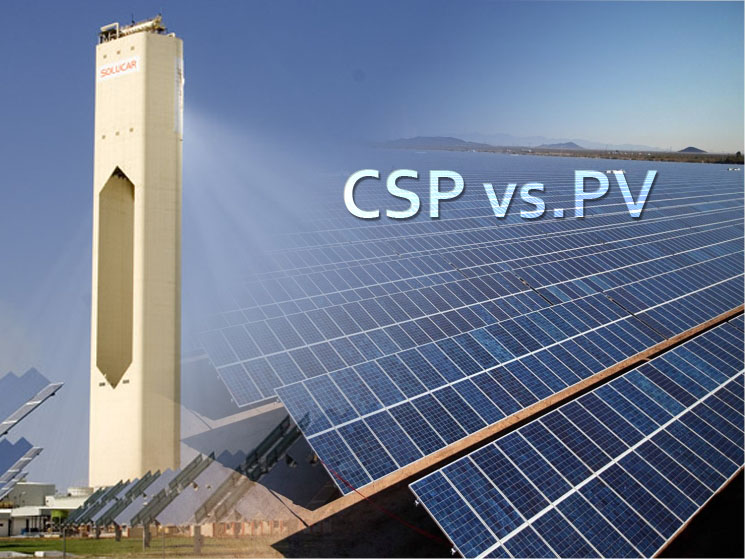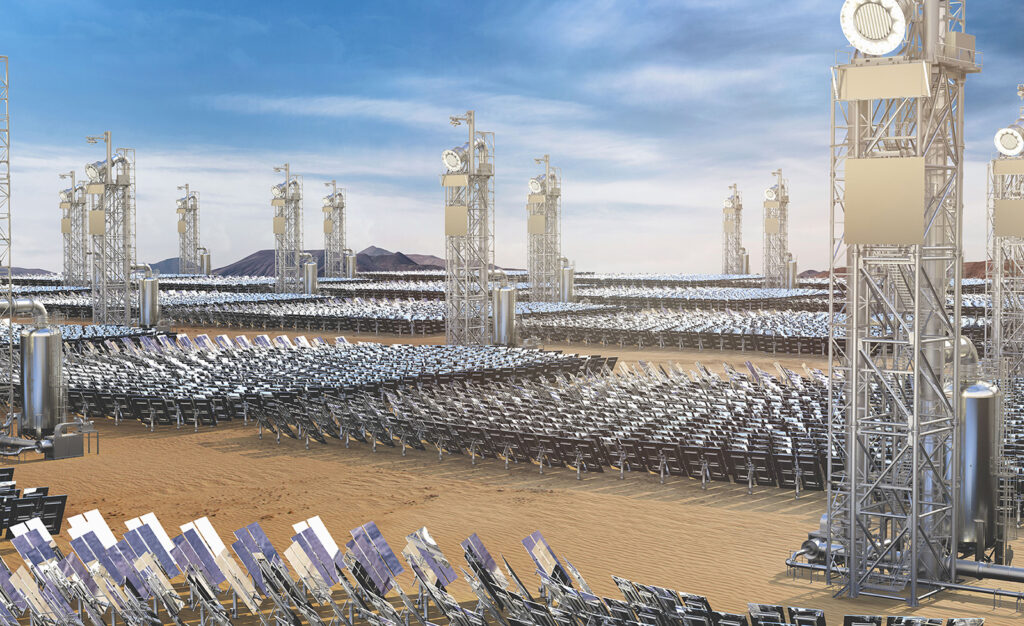INTEGRATED SOLAR PLANTS BLEND CSP AND PV

Image: HELIOSCSP
Next-generation modular concentrated solar power (CSP) plants fulfill the promise of round-the-clock clean power generation, but they shouldn’t be construed as substitutes or replacements for PV. Instead, the two technologies complement one another to produce the lowest possible cost (LCOE) for 24/7 electricity in most applications. An article in the CSP newsletter HELIOSCSP describes the advantages of a hybrid approach to solar power plant design.
Author Terrence West begins, “Integrated Solar Thermal Hybrid Power Plants … combine the strengths of both solar thermal [CSP] and photovoltaic (PV) technologies, harnessing the sun’s energy to generate electricity in a more efficient and cost-effective manner.”
Complementary differences
The principal advantage of hybrid power plants is their ability to generate electricity even when the sun is not shining, at a lower cost overall than PV and banks of expensive batteries. This is because the two technologies operate differently. In a nutshell,
- PV plants convert sunlight directly into electricity using photovoltaic cells. PV plants are relatively inexpensive to install and maintain, but they are not as efficient as CSP plants.
- CSP plants use mirrors to concentrate sunlight and heat a fluid, which then drives a turbine to generate electricity. CSP plants are more efficient than PV plants, but they are also more expensive to install and maintain.
- Integrated solar power plants combine the strengths of PV and CSP plants. They are more efficient and reliable than either PV or CSP plants alone, and they are more cost-effective in most cases.
Combined benefits
PV plants are best at generating electricity during the day, while CSP plants are best at generating electricity at night. By combining PV and CSP, hybrid plants can generate reliable electricity around the clock. Hybrid solar power plants offer a number of additional benefits over either PV or CSP alone.
- They generate more energy over time.
- They offer improved reliability of power delivery and system resilience.
- They can provide backup power during extended periods of bad weather or grid outages.
- They can help to stabilize grids by providing a more constant source of electricity.
- They also generate heat, which can be used for industrial processes or space heating.
The main challenges of integrated solar power plants are higher upfront costs relative to PV and increased system complexity. However, as we continue to develop 24/7 clean power and heat solutions for customers around the globe, we find that a hybrid CSP + PV approach is almost always the most economical solution over time.
Contact us to learn more.
ROUND-THE-CLOCK CLEAN CLEAN ELECTRICITY AND HEAT
400kWe 247Solar Plants deployed at scale
247Solar Plants™ bridge the gap between conventional wind and solar and the need for round-the-clock utility power and industrial-grade heat. 247Solar Plants store the sun’s energy as heat instead of electricity, for 18 hours or more, at much less than the cost of batteries. No generators are required, and 247Solar’s turbines can also burn a variety of fuels, including hydrogen, to ensure 24/7/365 dispatchability.
Extensive Applications
On-grid or off-grid, 247Solar Plants offer a 24/7 alternative to fossil fuels for a broad range of applications:
- CHP: 24/7 low-carbon Combined Heat & Power for industry
- Ultra Heat: Each 247Solar Plant can provide up to 1,500,000 Btu/hr. of heat at temperatures up 1000℃/1800℉ for industrial processes such as cement, glass, steel making, or minerals processing
- Microgrids: Always-on, emissions-free electricity and heat for islands, mines, communities, facilities
- 24/7 baseload power: 24/7 solar electricity, especially for emerging economies
- Green Hydrogen: 24/7 solar electricity and heat to power electrolysis around the clock
- Green Desalination: 24/7 solar electricity and heat to purify water around the clock
SHIPPING SUNSHINE: AUSTRALIA IS BECOMING A CLEANTECH SUPERPOWER
 “The energy transition’s most underrated country could be coal-titan Australia.” So says Cipher’s Bill Spindle as he spotlights two articles in the Daily Mail and New York Times that make his point. The Daily Mail piece reports that Australian Prime Minister Anthony Albanese has urged Australia to take up the opportunity to become a renewable energy superpower. Albanese warns that his nation cannot afford to just watch and react to the clean energy transformation or rely on breakthroughs in technology. ‘We have to seize these opportunities,’ he said.
“The energy transition’s most underrated country could be coal-titan Australia.” So says Cipher’s Bill Spindle as he spotlights two articles in the Daily Mail and New York Times that make his point. The Daily Mail piece reports that Australian Prime Minister Anthony Albanese has urged Australia to take up the opportunity to become a renewable energy superpower. Albanese warns that his nation cannot afford to just watch and react to the clean energy transformation or rely on breakthroughs in technology. ‘We have to seize these opportunities,’ he said.
In the New York Times’ Australia Letter, writer Natasha Frost interviews Alan Finkel, the former Australian chief scientist and author of the new book, Powering Up: Unleashing the Clean Energy Supply Chain. Says Alan, “We have an opportunity to become an electro-state of the future … There are two ways Australia can contribute to the future zero-emissions economy: One is through providing resources, and the other is through shipping sunshine.”
He continues, “The transition to zero-emissions energy to replace all of our fossil fuels is going to require a huge amount of resources, including copper and aluminum. We’re also going to have to massively ramp up battery materials, like lithium, nickel, manganese, cobalt and graphite, and rare earth elements, which Australia has a lot of.”
“Then there’s what I call ‘shipping sunshine.’ In a future where we have weaned ourselves off coal, oil and gas and replaced it with zero-emissions electricity and zero-emission hydrogen, energy still needs to be traded. There will be countries that don’t have the land for the solar power, and don’t have a suitable wind resource, and they’ll need to import energy.”
Read the full interview here.
PROPOSAL TO INCREASE CLEAN ENERGY INVESTMENT IN DEVELOPING COUNTRIES

CarlFourie/iStock
Bloomberg’s Akshat Rathi writes that a proposed currency-rate guarantee program by the International Monetary Fund could attract private investors to many more solar and wind projects. Describing the problem, he says, “Solar and wind power are the cheapest sources of energy in most of the world. And yet, there is a yawning gap in the current investments in clean energy compared to what’s needed to meet climate goals.”
“That disparity,” he continues, “is mostly down to a dearth of investments in developing countries. In 2020, more than half the world’s population, mostly in emerging economies, got less than 15% of global investments in clean energy.”
One explanation he cites is that most of the world’s capital sits in advanced economies, while most of the need for clean-energy investments is in emerging markets. Yet investors continue to shy away from emerging markets, in large part because of what economists call macroeconomic risks. One such risk has to do with currency exchange rates.
Rathi gives the example of a solar farm in South Africa that an American investor is interested in funding. The investor seeks a steady return in US dollars, even though the revenue generated from the farm will be in South African rand. Hedging that exchange-rate risk can cost as much as 8% of the annual revenue of the solar farm, which eats into the profit of the investor.
A white paper by Avinash Persaud, an economist who is the special finance envoy for Barbados, suggests that the International Monetary Fund should set up a partial currency-exchange guarantee. Because the IMF can operate across more than 100 currencies, it will be able to pool currency risks much better than private investors can do today, which would lower the effective hedging costs that investors pay and encourage more investment in countries where the greatest need exists.
Read more here.
FOLLOW & JOIN 247Solar
LinkedIn US, LinkedinEU, Twitter, YouTube
Contact: info@247solar.com
